Recently I’ve found some old photos of my turtle from when he was just a couple of months old, and I’ve noticed that there is a slight difference in the colors of his shell. And that made me wonder, do turtles change colors as they grow older, or was it just my imagination. So I did decide to do some research to find out, here is what I found out.
Do turtles change colors? Yes, turtles will change colors over time. The intensity of the change differs from species to species, and the environment that they live in also plays an important part in the color change.
Some turtle species will go through much more intense color changes, while others will only go through small changes. But we have to remember that the colors that turtles have are that way for a reason and that they also change for a reason, and it usually has something to do with survival. In the rest of the article, I am going to tell you why turtles have such different colors and patterns, how they change them over time, and much more.
What Causes the Different Shell and Skin Colors of Turtles ?
The things that cause the different shells and skin colors of turtles are survival and the environment. The overall color patterns of turtles’ shells and skin helps them at capturing prey and avoid predators.
The colors of a turtle will depend on the habitat where it’s living. They will usually have colors that blend with the environment, and that attract as little attention as possible.
A box turtle that you see on a road or in a terrarium might seem colorful and attract your attention as soon as you see it, but in its natural habitat, a wooden area where you can see small streaks of light on the ground that is filled with yellow and brown leaves, you will have a harder time noticing the turtle. Due to its colors, the turtle is able to easily avoid predators and it’s able to go undetected by possible prey.
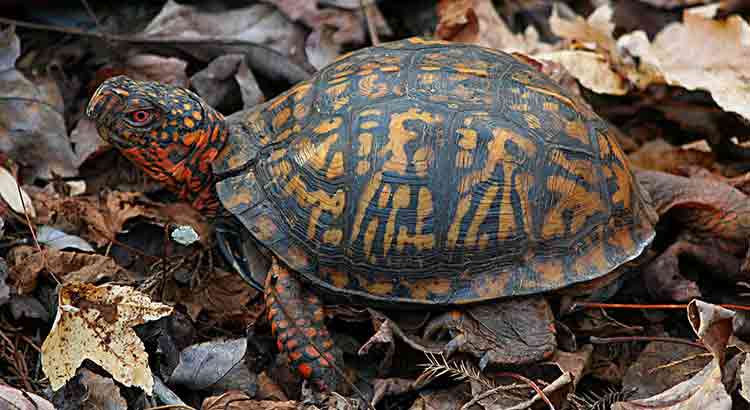
The dark shells of mud and snapping turtles work in the same way. The color allows them to easily blend in with the muddy substrate of the lakes and ponds where they live. And since they blend with the mud so well they will be unnoticed by possible predators and prey.
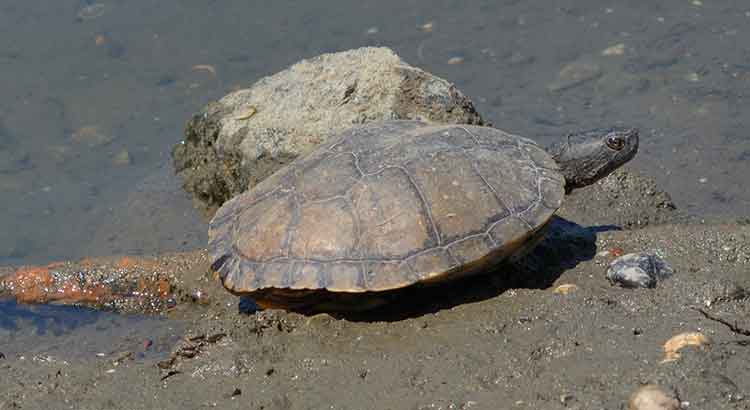
The same principles apply to turtles that have softshell. For example, the softshell turtle has the color of the sand or mud of the area that they live in, this thing offers them the same advantages when it comes to survival.
Sea turtles’ colors work in the same way. Leatherback turtles for example have the bottom half black with small white dots, and the bottom half white. The dark half allows them to hide from predators and prey that are above it, since the colors mix well with the dark floor of the ocean, and the other white half allows them to mix with the white, shining part of the ocean. This kind of color scheme is actually adopted by most creatures that live in the ocean since is so efficient, even sharks that are among the biggest predators in the oceans have a similar color scheme.
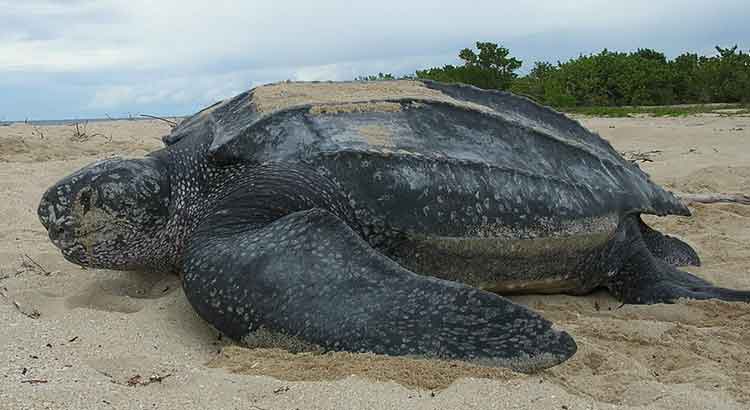
The physiological cause of the light and dark concentration that occurs in certain species are the levels of melanophores that produce dark coloration, and the pigment cells ( chromatophores ) that produce red and yellow.
Is There a Reason for the Patterns on the Shell of a Turtle?
Yes, every pattern on a turtle’s shell has a reason for being there. Some turtle species have complex, detailed, colored, and consistent patterns that are used for identification. Other turtle species have very simple and monochromatic designs on their shells. But no matter what kind of pattern they have on their shells, it’s always useful as a form of camouflage that acts as a protection for the turtle.
The swirls on the shell of a cooter turtle will look like ripples on the water surface, for a bird that is flying above looking for something to eat.
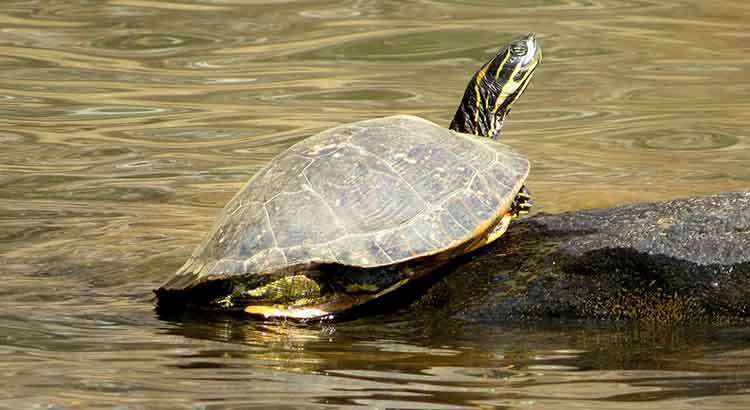
The yellow, red, and orange rings of the ringed map turtle also act as camouflage from birds who will think that the turtles are part of the vegetation.
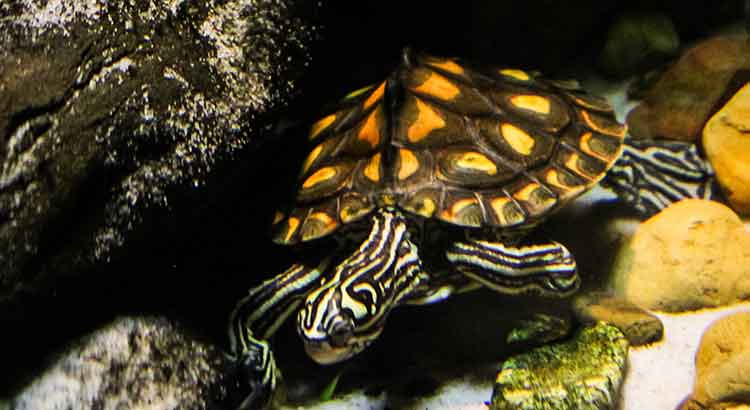
The contrasting patterns of a red-eared slider turtle work in a similar way to the pattern of a leatherback turtle. So the yellow underside will help them avoid water predators, like gars or catfishes, and the upper side will help them evade aerial and land predators.
Do Turtles Colors Change as They Grow ?
Yes, as turtles grow they change colors. Baby turtles will always be more brightly colored than older turtles, and they might even have different patterns on their shells. They will remain with those colors of at least a year or two after which their patterns will start to change and become similar to those of older turtles, and their colors will become muted or darker, depending on the species.
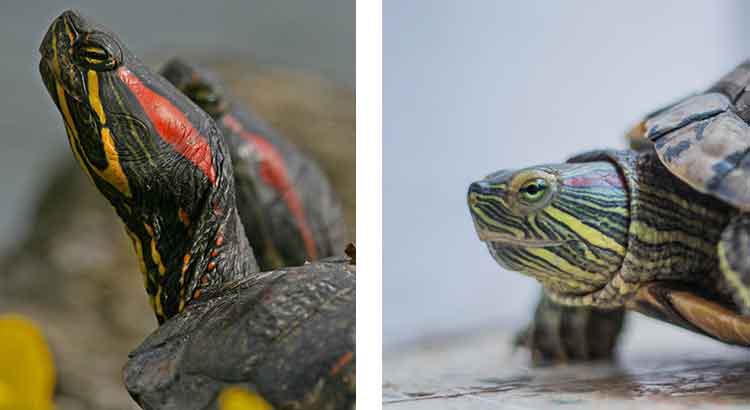
But there are species that will remain with the same colors and patterns throughout their entire life. For example the painted turtles of North America. Baby painted turtles are born with the exact same colors and patterns that their parents have and they will keep them for their entire lives.
Some turtles have very different colors as adults than what they had when they were hatchlings. For example, the adult eastern mud turtle has a dark brown carapace and dull yellow-brown plastron. But as a baby, it has a black shell and bright orange or red plastron with black streaks. During their first year, the colors start to fade and they transform into the typical yellow-brown that adults have. Even if this change is not very aesthetically pleasing it’s a lot safer for them since they can blend with the environment better.
Baby gopher tortoises are born with big yellow spots on their shells that fade away as time goes by.
In general baby, turtles have brighter colors, but that is not always the case. An exception to this is represented by the baby box turtles that are born with more muted colors and patterns than those of adults. Adults have bright black, yellow, and orange as part of their colors, those colors make them a little more easy to spot in their habitat, than the muted colors of baby box turtles that have the same colors but muted and with more shades of brown. Those muted colors of the babies allow them to blend in better with the first floor and have a better chance at reaching adulthood.
Slider turtles go through one of the most noticeable color changes as they age and grow larger. Male adult slider turtles become melanistic as they grow bigger and older, and as a result, they lose all of their yellow coloration of the limbs, head, and shell, including the yellow or red spots characteristic of the yellow-bellied or read-eared sliders.
This phenomenon has been studied in the book “Life History and Ecology of Slider Turtle”. After they examined thousands of slider turtles they reached the conclusion that melanism is a gradual change from brightly colored immature male slider turtles to the dark gray or black patterning associated with older individuals. The variability in males from the studied population was high, but it did not occur until males reached sizes at which females reached maturity. This has led the researchers to believe that melanism may aid in mate selection during the courtship phase.
Do Turtles Colors Change With the Seasons ?
Yes, the color pattern of almost all turtle species stays the same through all the seasons, but there are a few species that change colors as the seasons change. Those changes aren’t as dramatic as the changes a chameleon goes through when it changes its color, but they are still noticeable.
The most dramatic color change occurs in painted terrapins that live in Malaysia, Sumatra, and Borneo. The painter terrapins usually have a nondescript gray head and some dull red stripes down the center of the top of their head. During the mating season, the head of the males becomes white and the dull red of the stripes becomes a very bright and powerful red. This change helps them find a partner during the mating season, no other benefit of the color change has been found.
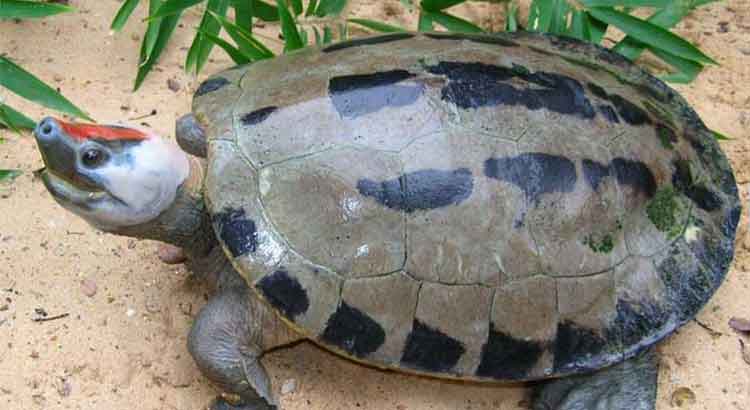
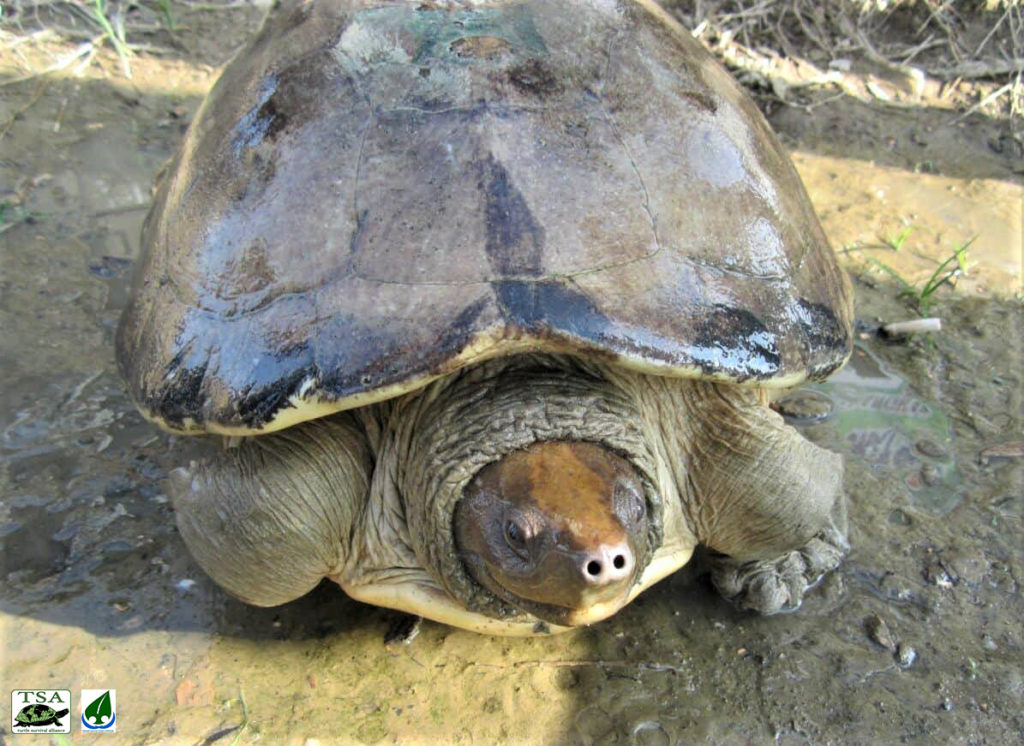
Painted Terrapin during the nonmating season. Photo by the courtesy of TSA
The male river terrapins also change colors during the mating season. Their shells are usually a pale gray that goes unnoticed, but during the mating season, their shells become darker, almost black. Again, there is no other practical reason for this change, except for attracting partners.
There are other turtle species that change colors during the mating season, but they are harder to notice. There is also the possibility that all turtles change colors during the mating season but they are too subtle for us humans to observe.
There are no turtle species that change colors because the temperature outside has changed. So you won’t be able to see a change in colors in your turtles if you change the temperature of the room, the only season that they change their colors is the mating season, which has little to do with the temperature.
What Color are the Eyes of a Turtle ?
Like most animal species the color of the eyes can differ from individual to individual, but there is usually a defining color among some species.
Most turtles have yellow or yellow-brown eye color, with black pupils. The second most common color is brown and darker variations of it. But there are some species that have very different colors from the rest of them.

For example, the male common box turtles and the spotted turtles often have eyes that are colored in different shades of red. On the other hand, the females usually have yellow or yellow-brown eyes. There is no known benefit of the red color, but most biologists assume that it can be an advantage during the mating season and that females could be attracted to male turtles that have red eyes.
There is also the false map turtle species that is divided into two subspecies, the midwestern false map turtle, and the Mississippi false map turtle. The midwestern subspecies have a yellow-brown iris and a horizontal black bar running through the pupil. The Mississippi subspecies has a white iris, a black pupil, and no black bar.

The adult male mangrove terrapins of India and Southern Asia have an iris that is light-colored, usually white or light shades of yellow. On the other hand, the adult female mangrove terrapins have brown eyes.
There are also some turtle species that have blue eyes. The brown-roofed turtles that live in India are one of those species. Another group of turtles that have blue is those that belong to a subspecies of the Spanish terrapins that live in Morocco.
In general, the configuration of the pupils and pigmentation varies from species to species, but it usually appears as a black circle or a black bar. But there are also some different shapes that they can take, for example, the alligator snapping turtle has star-shaped eyes. And the Malaysian giant river turtle has brown eyes with an outer circle of blue iris.

Can Turtles From a Single Species Have Different Colors ?
Yes, there are a lot of turtle species that are divided into subspecies just because they have different colors. One of the biggest factors that made those turtle species divide into subspecies with different colors is the habitat where they live.
One of the best-known examples is the slider turtle which is divided into three subspecies: the yellow-bellied slider turtles, the red-eared slider turtles, and the Cumberland slider turtles. The yellow-bellied slider turtles have a yellow blotch or broad stripe on each side of the head behind the eyes, and a yellow plastron with two black spots at the front.
On the other hand, the red-eared slider turtles have the markings behind their eyes red, and a yellow plastron with numerous black spots, usually one per scute. The Cumberland slider turtles are more similar to the yellow-bellied slider turtles than to the red-eared sliders, because they also have yellow stripes on their heads, but they are a lot narrower. Aside from those color differences, all three subspecies are identical in ecology and behavior.
Another great example is the common box turtle which is divided into four subspecies that have very different shell colors and to a small degree a different shell morphology.
The variations of the striped mud turtle were unknown for a long time. When the species was first discovered, the bright yellow stripes down the center and the sides of the shell were a signature characteristic of the species. Initially, the striped mud turtle was known to live in Florida and some parts of Georgia, and later the turtles were also identified in Carolina and Virginia. As a result, a lot of confusion was created because the northern population has pale or nonexistent stripes. In the end, they kept the two populations as one species, but one species that have very different visual characteristics.
The diamondback terrapins have one of the biggest geographic variations, which means that they are also divided into a lot of subspecies that have different colors and visual characteristics. The diamondback terrapins have a narrow distribution from Cape Cod down the East Coast, around the peninsula of Florida all the way to Texas.
There are seven subspecies that all have variations in the way they look. Some of those subspecies have different patterns on their shells than the rest, some of them have whiter skin, while some of them have darker skin. There are a lot of differences between those subspecies. Diamondback terrapins are one of the most varied species of turtles in the world.
Do Albino Turtles Exist ?
Yes, every animal can have an albino. An albino is somebody or something that has no black pigments, and as a result, they are completely white and have slight variations of white and pink.
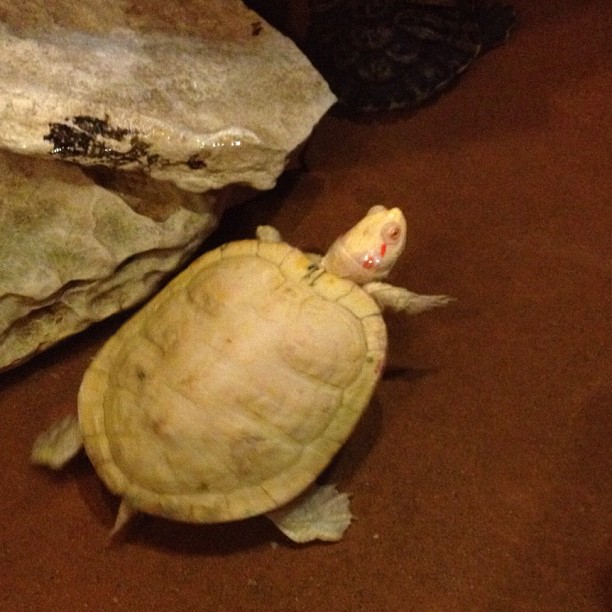
Conclusion
So most turtles will change their colors over the course of their lifetime, most of them will go through this change in their first years of life, and some other turtles will change colors when the mating season arrives.
Turtles have some of the most interesting and unique patterns on their shells, but those patterns are not there just to give them a pleasing aspect, they act as a defense mechanism that helps them camouflage so that they can avoid predators and catch prey.
If you just got a new baby turtle, you can take some close-up photos of its shell now, and a couple more after 6 months, or a year, and then you can compare them to see the differences. This is a great way to observe the change in colors. Since they will change slowly over time it’s really hard, almost impossible to notice the change from day to day.
I hope this article answers every question you had about turtle colors. If you have a question that hasn’t been answered in this article leave a comment with it and I will answer it as soon as possible.

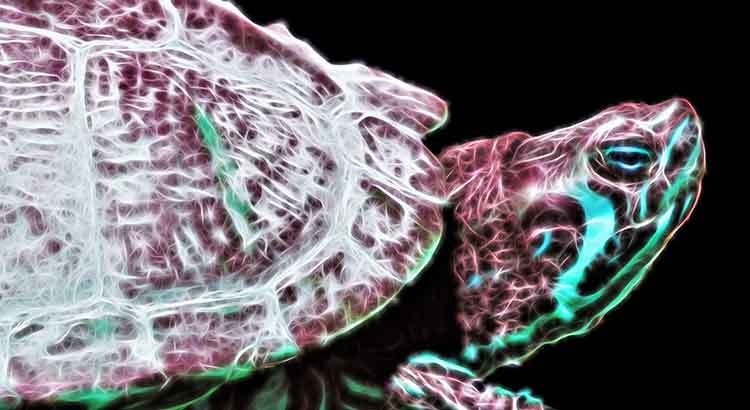

I wanted to ask your opinion and call on your expertise for a situation. About 10 days ago we saved a red slider female from being run over on a highway. She seemed somewhat traumatized so we took her in so she could feel safe and secure in our house. She didn’t eat for a few days but is now eating and wandering through the house. Her plastron is a beautiful yellow color with a design, but in the past 24 hours it has turned totally dark, almost black. We’re not sure if it’s an adaptation to our dark wooden floors to blend in, or if there is something else going on, but we would like to help her. Her shell measures about 8 inches front to back and she has become friendly and mobile. I don’t believe it is shell rot, there is no smell and it is not breaking off, but it has gone from a bright yellow to dark in the past 24 hours or so. Her activity level is good and she is eating. Suggestions very welcome. Thank you in advance for any help you can offer.
It’s wonderful that you rescued the red-eared slider and provided her with a safe and caring environment. The change in the color of the plastron is interesting, and it can indeed be due to a variety of factors. Here are a few possibilities to consider:
Adaptation to Environment: Turtles can sometimes exhibit changes in coloration, such as darkening, in response to their environment. If she is now on dark wooden floors, it’s possible that her body is adapting to blend in with the new surroundings.
Thermoregulation: Turtles sometimes change their body temperature by altering their shell color. Darkening of the plastron can help them absorb more heat from a light source, such as a basking light, to regulate their body temperature more effectively.
Mood and Health: Changes in coloration can also be related to the turtle’s mood, health, or stress. For instance, stress or illness might lead to a change in shell color.
Since your turtle is active, eating, and doesn’t display any signs of shell rot, it’s possible that this change in coloration is related to adapting to her new environment or thermoregulation.
However, it’s a good idea to monitor her closely for any other changes in behavior, appetite, or any signs of illness. If you notice any further concerns or if the color change persists without an apparent environmental cause, it might be advisable to consult a reptile veterinarian. They can provide a thorough examination and offer more precise guidance on the specific situation, as well as any potential health concerns. Your care and concern for the turtle’s well-being are truly appreciated.